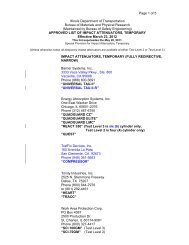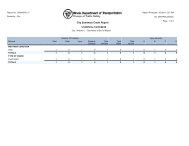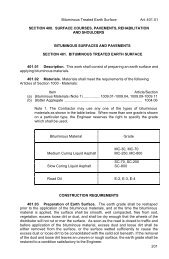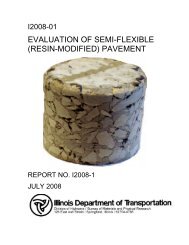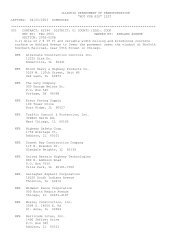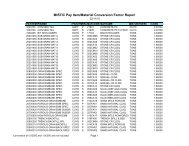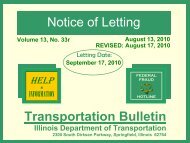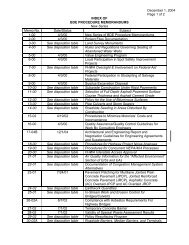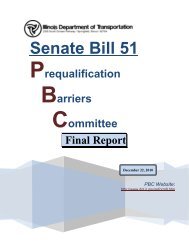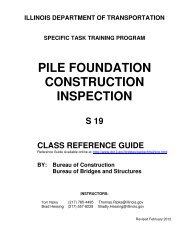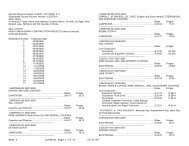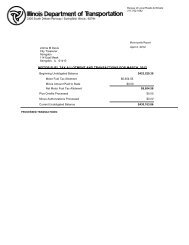Quarterly Management Report on Research Progress - Illinois ...
Quarterly Management Report on Research Progress - Illinois ...
Quarterly Management Report on Research Progress - Illinois ...
You also want an ePaper? Increase the reach of your titles
YUMPU automatically turns print PDFs into web optimized ePapers that Google loves.
<str<strong>on</strong>g>Quarterly</str<strong>on</strong>g> <strong>Progress</strong> <str<strong>on</strong>g>Report</str<strong>on</strong>g><br />
Paul Tennis ptennis@cement.org<br />
Meeting Dates - Minutes Available?<br />
<strong>Progress</strong> & Significant Results This Quarter:<br />
Brief Summary of the Project Status<br />
1. Many meetings were held with John Huang (Chairman of TRP) and John Melander (PCA) at IDOT District 1, UIC, and at PCA facilities to<br />
discuss the progress of the project including the problems encountered and test results.<br />
2. Several individual and group meetings were held at UIC with John Huang, John Melander, Ready mix c<strong>on</strong>crete representatives, admixture<br />
representatives, and cement representatives to witness the mixing operati<strong>on</strong> and other testing procedures.<br />
3. Most of these meetings were held to find a soluti<strong>on</strong> to the difficulties that are encountered in achieving stable air system using the c<strong>on</strong>crete mix<br />
designs specified for the project by <strong>on</strong>ly using WRDA 82 and DARAVAIR 1400 except the mix with fly ash and natural sand.<br />
4. The mixes that include combined sand and/or slag produce very harsh mix. If adding <strong>on</strong>ly WRDA 82, a large amount of WRDA 82 (much more<br />
than the limit of 3.5-5.0 fl.oz/CWT) is needed to achieve the required slump. However, the air entraining admixture WRDA 82 dosage required is<br />
greater than what is recommended by the manufacturer. Adding this large amount of WRDA 82 will yield a large amount of faked fresh air in the<br />
mix that was not reflected in the hardened air as revealed lately in the hardened air void system.<br />
Other Activities:<br />
• In the sec<strong>on</strong>d week of December 2011, I invited Jim Kolakowski and Jeff from Grace and Scott from Ozinga to witness and find a way to<br />
stabilize the air c<strong>on</strong>tent in the fresh state for the problems encountered for this harsh mix for the c<strong>on</strong>crete mixtures using the aggregates and<br />
cementitious materials specified in the test program. They identified and introduce combinati<strong>on</strong>s of a HRWR (ADVA CAST 575) and air entraining<br />
admixture (Darex II). With their presence several trials were made using these combinati<strong>on</strong>s.<br />
• On December 20, 2011, I met with John Melander at UIC to follow up and to discuss the suggested combinati<strong>on</strong>s of HRWR (ADVA CAST<br />
575) and air entraining admixture (Darex II) that were introduced by Jim Kolakowski and Jeff from Grace and Scott from Ozinga. The<br />
combinati<strong>on</strong>s ADVA CAST 575 and Darex II did work and provide stable fresh air c<strong>on</strong>tent at 30 and 45 minutes in c<strong>on</strong>crete mixtures using the<br />
aggregates and cementitious materials specified in the test program in the fresh state.<br />
• John Melander indicated and suggested to make c<strong>on</strong>crete specimens from trial batches and check the hardened air at 14 days to c<strong>on</strong>firm that<br />
they are achieving the desired hardened air parameters prior to mixing full-size batches for durability testing.<br />
• We made some of these trial mixtures using Darex II and ADVA CAST 575 to evaluate effect <strong>on</strong> air c<strong>on</strong>tent stability in the fresh and hardened<br />
state.<br />
• The testing for the air void system is in progress. After all these trials I will plan to schedule a project review meeting with the TRP to review<br />
the informati<strong>on</strong> from these trial batches before proceeding to cast more durability test specimens.<br />
Anticipated Work Next Quarter:<br />
On January 5, I met with John Huang (chairman of TRP) to brief him <strong>on</strong> the latest development in the project. As a result of this meeting, John<br />
Huang recommended the use of natural admixtures WRDA 82 and Daravair 1400 in the c<strong>on</strong>crete mixtures in the following format:<br />
1. Use WRDA 82 as the base water reducer to its limit of 3.5-5.0 fl.oz/CWT and if additi<strong>on</strong>al slump is needed use other additi<strong>on</strong>al HRWR such as<br />
ADVA CAST 575 or Daracem 19.<br />
2. Use DARAVAIR 1400 air entrainment.<br />
3. WRDA 82 and DARAVAIR 1400 are natural admixtures that are likely to be used.<br />
4. ADVA CAST 575 and Darex II are synthetic admixtures that might be used if needed.<br />
5. Make your best using natural admixtures.<br />
John Huang also suggested to do the following mixes for the following ingredients:<br />
1. Cement + fly ash + natural sand, add either:<br />
a. WRDA 82 + DARAVAIR 1400 (natural admixtures) or<br />
b. ADVA CAST 575 + Darex II (synthetic admixtures)<br />
2. Cement + fly ash + combined sand, add either:<br />
a. WRDA 82 (3.5-5.0 fl.oz/CWT) + ADVA CAST 575 to achieve required slump + DARAVAIR 1400 or<br />
b. ADVA CAST 575 + Darex II (synthetic admixtures)<br />
3. Cement + slag + natural sand, add either:<br />
a. WRDA 82 (3.5-5.0 fl.oz/CWT) + ADVA CAST 575 to achieve required slump + DARAVAIR 1400 or<br />
b. ADVA CAST 575 + Darex II (synthetic admixtures)<br />
4. Cement + slag + combined sand, add either:<br />
a. WRDA 82 (3.5-5.0 fl.oz/CWT) + ADVA CAST 575 to achieve required slump + DARAVAIR 1400 or<br />
b. ADVA CAST 575 + Darex II (synthetic admixtures)<br />
90<br />
Page 2 of 3



